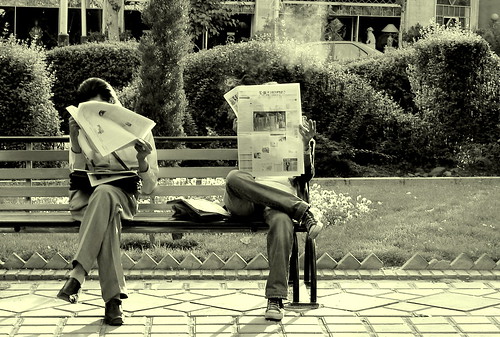He’s pitching a plan to save newspapers, and it’s based around the idea that newspapers should begin charging for all-access passes to their sites. And when he’s giving his pitch, just before he’s finished riling newspaper executives into believing that the public is just going to start handing over money in exchange for the printed word, he mentions that journalists are going to have to “change consumer expectations that journalism is free on the web.”
Steve Brill is wrong.
He’s not wrong that journalists are going to have to change the way the public thinks about paying for news. He’s entirely right about that, actually. Free, sadly, is not a sustainable business model.
But he’s wrong when he characterizes this as an “expectation.” It’s not. It is, sociologically speaking, a norm.
If I go to a bar and buy a beer, I’ll leave a dollar for the bartender. Society understands that bartenders work on tips, and we’re willing to self-police those who don’t tip well. There is no requirement that you tip; but certainly, those who tip poorly (or not at all) will be shamed by their peers for breaking a norm.
And if I go a restaurant, eat, and then leave without paying, I’ll be prosecuted (or find my face suddenly plastered on every restaurant wall in town). You won’t find a society in the world where stealing is acceptable.
In the first case, the norm is enforced by peers. In the second, the norm is enforced by the owners of the establishment, or by police.
But look at what’s happening with newspapers. Society does not frown upon those who get their news for free, because:
A.) There’s no norm that says that good journalists should receive extra financing (via tips) from the public for performing a public service 1..
B.) There’s no norm that suggests that getting news for free is stealing.
And without going into the full, 10,000 word Malcolm Gladwell-style breakdown, I’ll say this: norms are hard to create, and even harder to break down.
Arno Peters is proof.
❡❡❡
What you’re looking is a map of the world as — according to many cartographers — it actually appears.
No, really.
In 1973, Peters presented that map at a conference for cartographers. He suggested that Mercator project map — first used in the 16th century — was inaccurate, as it distorted the size and shape of countries. The Mercator map was created for explorers — specially, European explorers — to use when traveling by sea. In that map, countries closer to the poles become especially elongated, while countries near the equator appear smaller.
Essentially, it’s a map that places Europe at the center of the world.
Supporters of the Peters project map say that the map does not treat the Southern hemisphere fairly. They’ll also note that Greenland has an area fourteen times smaller than that of Africa. But on the Mercator map, they appear similar in size 2..
But you won’t find the Peters projection map in elementary school classrooms, and for good reason: it looks ridiculous. The map you trust looks like this, and that’s the way that you’ll probably always envision the world. The norm — since the late 1500s — is that the Mercator map is the true representation of the world, and any suggestion otherwise would be to deny a universal truth.
Could we, as a country, come together and decide that the Peters map is the better, more truthful map? Hypothetically, yes. But it would take decades, because we’d have to change the public’s perception of how the Earth really appears. And can you imagine the looks on people’s faces when we tell them how big Africa really is?
❡❡❡
As new Internet users log online, they’re discovering all of this free content, and they’re already sinking into the idea that free content is normal. It’s those who are charging for content who are the abnormal ones.
The truth is, for newspapers, the window to succeed in changing this norm is shrinking every day.
So what can newspapers do? Maybe a model like Kachingle — which works like a tip jar for journalists — could work, and maybe society will make examples of those who aren’t tipping their favorite sources in the news industry.
Or maybe Steve Brill’s model will catch on, and society will accept the idea that reading news for free is stealing.
Maybe.
Here’s where I’d start: I’d prove that the content that I’m providing is essential. We can live without news of the weird or the latest baseball box scores. But we need news that allows us to remain a informed, dedicated citizenry. The newspapers that provide such essential content will survive.
If I’m going to argue — as newspapers are — that I’m essential to a democracy, then it’s about time I started living up to it. Do that, and maybe I can expect the public to starting paying up.
I’m not advocating premium content. I’m just advocating better journalism.
❡❡❡
1.) And can you imagine if journalists were told that they’d be earning a lesser hourly wage and then making back the rest of their salary via tips? One thing’s for sure: on a tip-based-model, you’d see journalists working harder than ever. >back to article
2.) If this sounds familiar, it’s probably because the map was featured in an episode of The West Wing. >back to article
H/T to Hamed Saber for the image at top, and petersmap.com for the map


